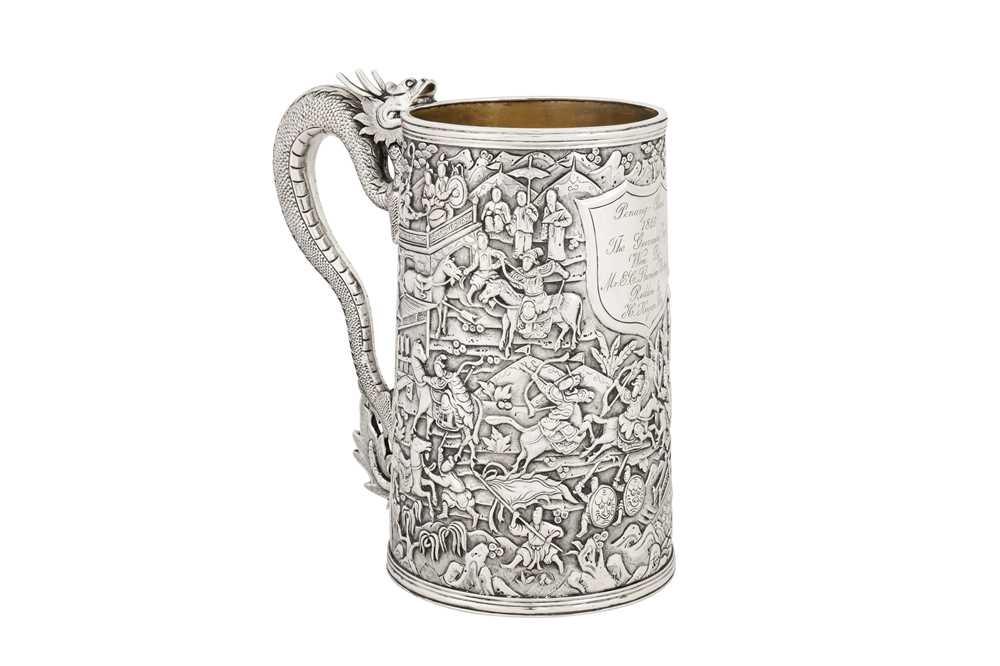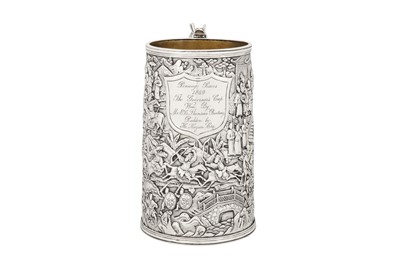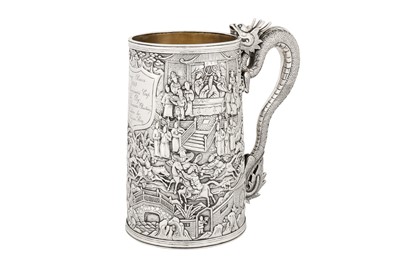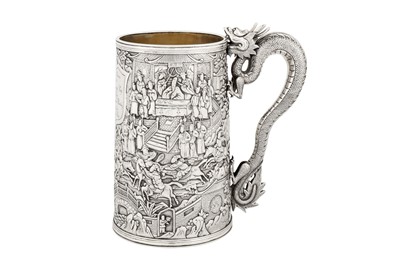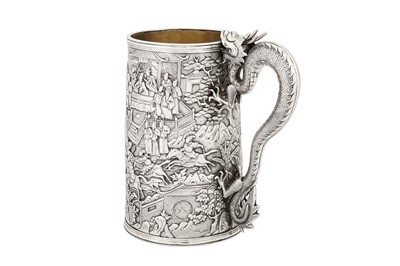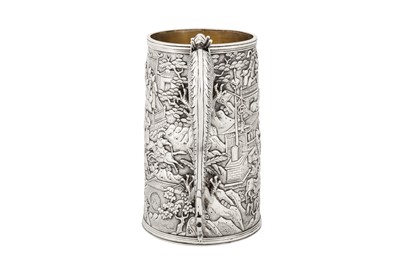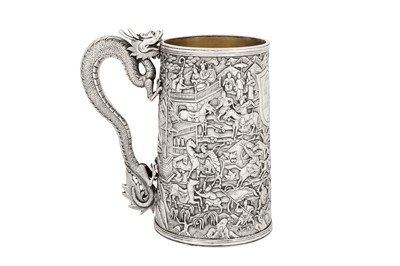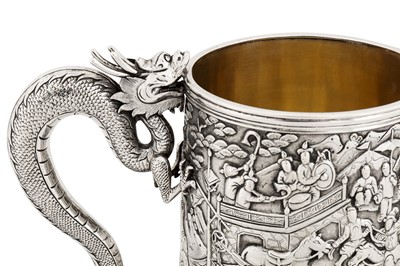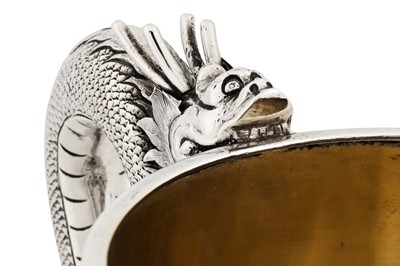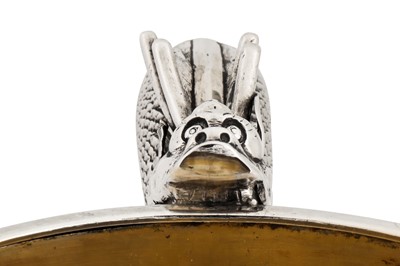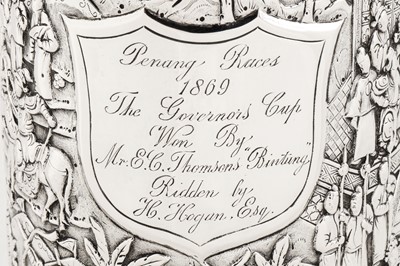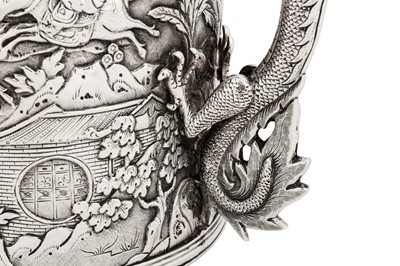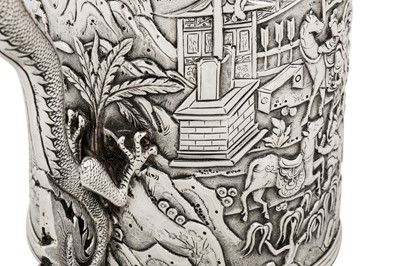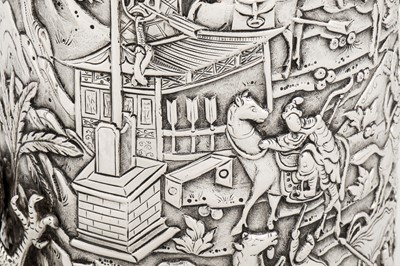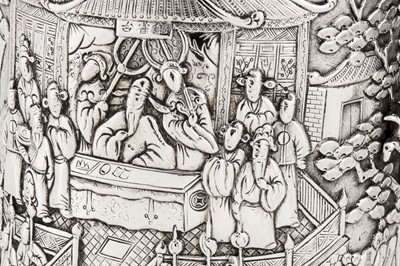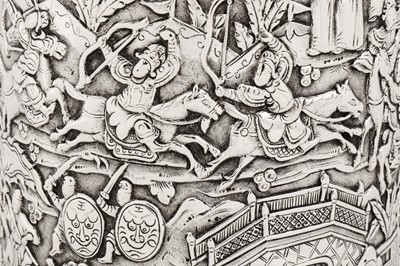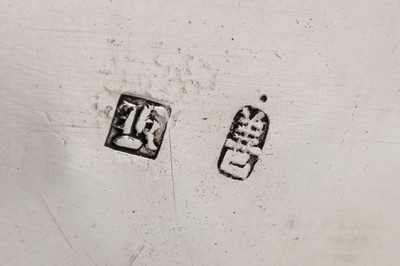11th Oct, 2023 11:00
Silver and Objects of Vertu
Penang interest – A rare mid-19th century Chinese export silver mug, Canton dated 1869 by Shan, mark of Khecheong
Penang interest – A rare mid-19th century Chinese export silver mug, Canton dated 1869 by Shan, mark of Khecheong
Qing dynasty. Of tapering cylindrical form with reeded rims. The handle formed as a Chinese dragon with saw cut and engraved frills and applied wrought work horns. The body with chased decoration of a continuous battle scene, including a terraced building with musicians, warriors on horseback with bows and arrow, swords, or lances, two warriors with large oval shields chased with grotesque faces, probably tiger shields, a seated emperor surrounded by dignitaries and guardsmen all before steps. The body otherwise with fir trees, willow trees, rocky outcrops, and a bridge in the foreground. The front with a shield shape cartouche engraved with a presentation inscription reading “Penang Races 1869, the Governors Cup, won by Mr E. C. Thompsons “Bintung”, ridden by H. Hogan Esq.”. Double skinned interior. Marked underneath with artisan mark 善 (SHAN) and retailer's mark of a gothic K.
Height – 17.7 cm / 7 inches
Weight – 615 grams / 19.77
This relating to the Penang Turf club established in 1864, the oldest of the three turf clubs in Malaysia, located at Macalister Road from 1869 to 1939. On the 1st April 1867 the Straits Settlements were transferred from the control of the Indian government to that of the secretary of state for the colonies in London (Colonial Office). Between 1867–1871, Major General Archibald Edward Harbord Anson (1826-1925), Lieutenant-Governor of Penang under Governor-General Sir Harry St. George Ord at Singapore (1819-1885).
The date of 1869 is of note as this is the same year as the opening of the Suez Canal, which because of the considerable increase in trade in the years to follow saw the port of Penang grow to become the major entry port for British Malaya. “Penang is an Island belonging to Great Britain, in the East Straits Settlements, at the north entrance of the Straits of Malacca, two miles from the Province of Wellesley. Penang, having a healthy climate, is a favourite resort for invalids. It produces Rice, Indigo, Cotton, Tobacco, Coffee, Sugar, and Tin Ore is also found. The trade is increasing. The capital, George Town, has a good and spacious harbour and barracks for European troops. The progress made by this Settlement is very satisfactory; and the increase of imports and exports had been considerable.” Street’s Indian and Colonial Mercantile Directory 1873. Where the silversmiths and jewellers listed are Attack Goon and Coyen Lee, who both are mentioned in the 1869 edition. In the 1869 edition it reports imports across a wide variety of goods of £1,811,301. 5s.3d, that the population including Wellesley was approximately £150,000 and that it was a 38 day journey every alternate Saturday from Southampton via the Peninsular and Oriental Company.
The Hogan family are one the longest established family of settlers in Penang, or as it was also known prior Prince of Wales Island. John Hogan (1795-1871) was one of three white men who accompanied Sir Stamford Raffles (1781-1826) when Raffles founded Singapore in 1819, then having moved to Penang in 1825. Singapore was united with Malacca and Penang as the Straits Settlements, still under British East India Company rule, in 1826. The Straits Settlements came under direct British rule in 1858 and became a crown colony in 1867. A H. Hogan could be for Henry Clarence Hogan (8th December 1855 – 1920), the first of many sons of Jonathan Edward Hogan (1835-1934) he the son of John Hogan (1795-1871). However, this is rather unlikely given his age in 1869.
This horse is almost certainly actually Bintang, who also reported in the Straits Times 27 Nov 1869 for Singapore, where he came in second for the Governors Cup against Iron Duke (first) and Plandit (third). It is stated here that the conditions for a Governor’s cup was given “under the condition that three new horses were to start, or no race.”. While the Pengang Gazette of 1869 detailing this race has not yet been located it would stand to reason it operated under the same principles as this Singapore race of the same year. Interestingly a later race on this Straits times is described as “(…) a two mile race for the Celestial Plate, the gift of the Chinese community (…)”.
Sold for £5,250
Includes Buyer's Premium
Do you have an item similar to the item above? If so please click the link below to submit a free online valuation request through our website.
